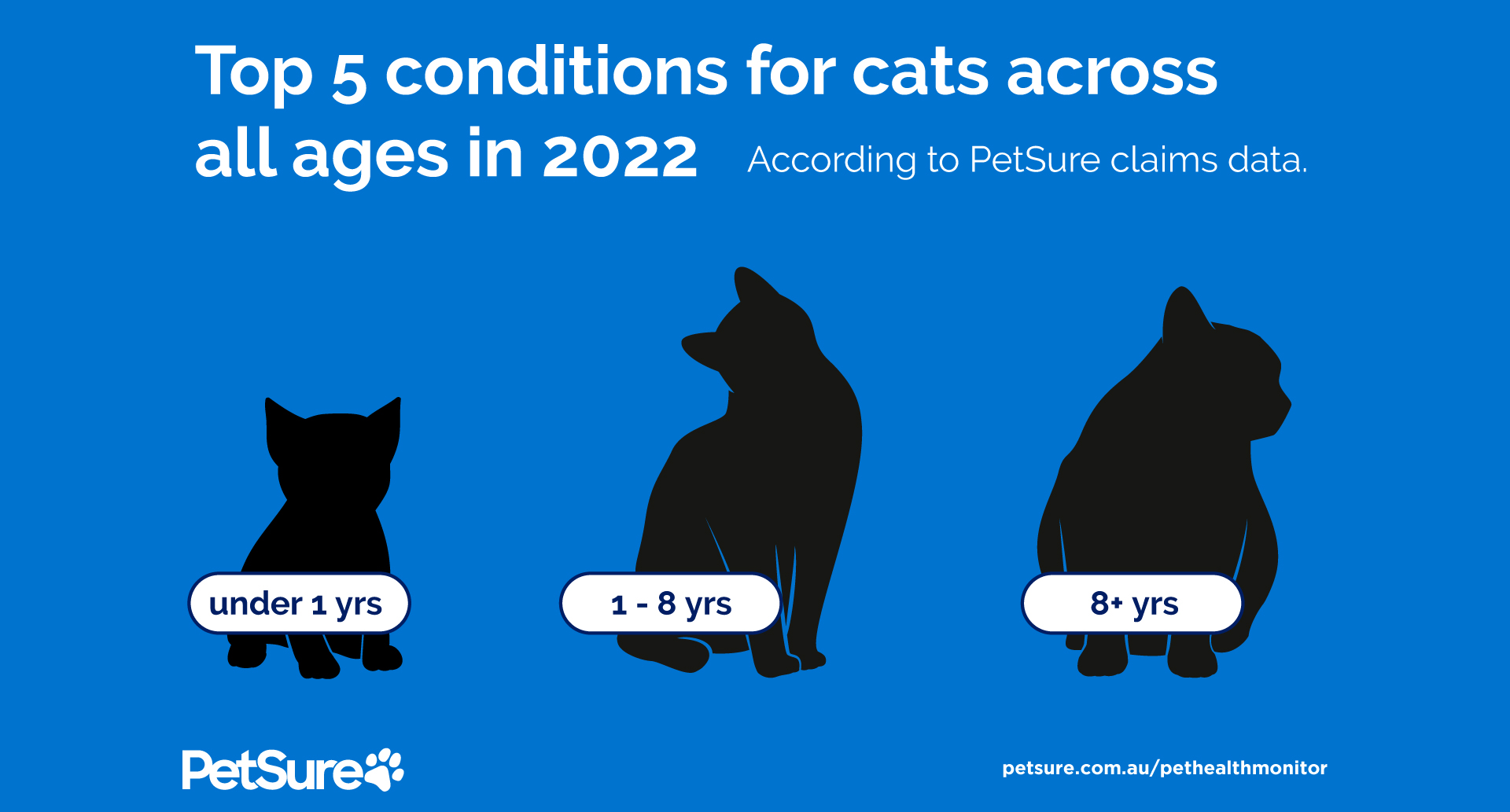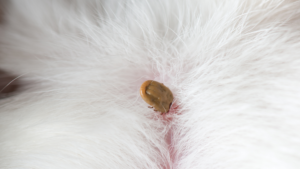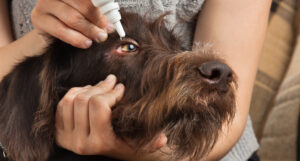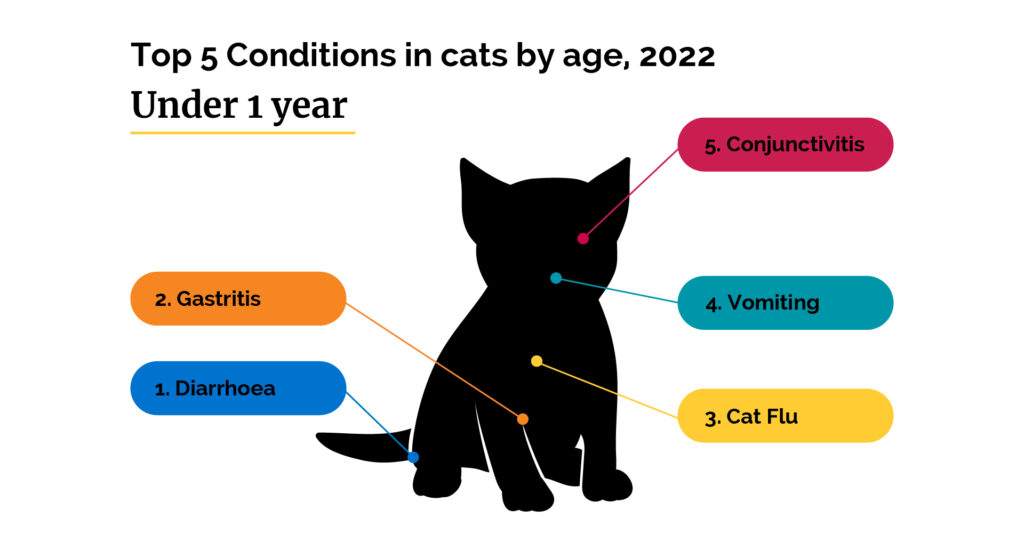
Top 5 Conditions under 1 year
- 1. Diarrhoea
- 2. Gastritis
- 3. Cat flu
- 4. Vomiting
- 5. Conjunctivitis
Gastrointestinal disease
Gastrointestinal problems including diarrhoea, vomiting and gastritis (inflammation of the stomach lining) in kittens under a year old are common. Young kittens can be susceptible to changes in the environment that can lead to digestive upsets. This can include changes in diet, introduction to a new home, and of course the weaning process itself.
Parasites, bacteria, and viruses can also contribute to gastrointestinal diseases in young cats. Exposure to toxic plants, or other household toxins, foreign objects, and other toxins in the environment can also be an inciting cause of gastrointestinal disease. Inquisitive young cats may be more likely to nibble on things that they shouldn’t, contributing to gastrointestinal upsets.
A general rule of thumb is that acute symptoms arising quite suddenly, are more likely to be caused by toxins, foreign bodies, or infections. On the other hand, chronic digestive symptoms that linger for some time, may be a sign of chronic inflammation of the gastrointestinal tract, food allergies or cancers, which are less likely in younger cats. It is also worth resembling that vomiting and diarrhoea can be signs of kidney, liver, or pancreatic diseases.
Ways to help your young cat avoid tummy upsets include:
- Introducing new foods gradually by mixing a small amount of the new food with the old food
- Avoiding giving young cats cows milk, as cats are often lactose intolerant and this can result in diarrhoea
- Ensure intestinal worming prevention is up to date
- Keep great hygiene around the home. Wash cat bowls daily with hot soapy water and allow them to dry completely. Ensure water is fresh daily. Always remove faeces from litter trays.
- Keep plants and other tempting items to chew out of reach of young cats
- Store medications, cleaning products and any other household toxins away from pets
- Keep your cat indoors or in a safe play enclosure so that you know what your cat is exposed to
Cat Flu
Cat flu is a common illness, a lot like a human cold it affects the upper respiratory tract of cats. It can be caused by several infectious agents, including viruses Feline Herpesvirus (FHV) and Feline Calicivirus (FCV), and bacteria Chlamydophila Felis and Bordetella Bronchiseptica. As a result, this can cause a runny nose and eyes, and a sore throat.
Other symptoms include aches and pains in the muscles and joints, mouth ulcers, dribbling, sneezing, loss of voice and fever. With cat flu, ocular signs are common including conjunctivitis and eye ulcers and particularly in kittens, can progress to cause serious damage to the eye. Young cats and kittens are more likely to be affected by cat flu due to their developing immune systems, as well as exposure to the virus in via their mothers, catteries, shelters, or pet stores. In very young kittens cat flu can become very serious and even cause death. Thankfully most young cats recover from cat flu although many will go on to have flare ups throughout their lives, particularly when stressed or unwell for another reason.
In many cases, your young cat will already have been exposed to cat flu before arriving home to you, but it may be possible to avoid infection by ensuring your cats are up to date with vaccinations, especially before entering boarding facilities. As cat flu is so common, it is very likely that your cat may have already been exposed in their lifetime. Cats who are carrying cat flu, avoid flare-ups by maintaining excellent nutrition, a stress free environment and addressing other health complaints promptly.
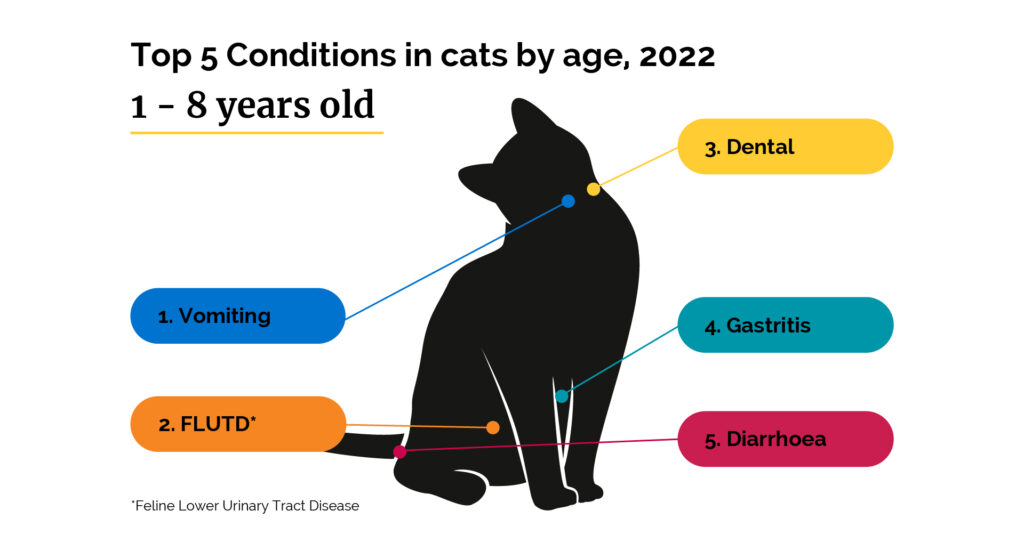
Top 5 Conditions 1- 8 years
- 1. Vomiting
- 2. Feline Lower Urinary Tract Disease (FLUTD)
- 3. Dental Disease
- 4. Gastritis
- 5. Diarrhoea
GI Disease
While younger kittens are more likely to have gastrointestinal upsets relating to infections, parasites, and changes in diet, as cats get older parasites and infections become less likely, and things like food intolerances, chronic inflammatory diseases of the gastrointestinal tract are more frequent causes of vomiting, diarrhoea, and tummy upsets like gastritis. Underlying diseases of other organs like the kidney, liver and pancreas can also contribute to gastrointestinal symptoms in cats.
Unfortunately, as cats get older, cancers can also be a cause of gastrointestinal symptoms in cats. Some cancers affecting the digestive systems of cats include leiomyosarcoma, adenocarcinoma, lymphoma and mast cell tumours. It is important to note that as cats get older, they would need to have regular check-ups with the vet, i.e. surveillance blood tests to monitor vital organ function such as liver and kidney function. In cases of chronic vomiting, make a note of how often your cat vomits and when it occurs in relation to food, as well as noting the content of the vomitus. Other things you can do at home include:
- Ensure excellent, premium cat food avoiding things with by-products, artificial colours, flavours and fillers
- Keep up to date with intestinal worming to rule out parasitic causes of gastrointestinal upsets.
- Avoid snack items that your cat might not be used to or that could be contributing to tummy upsets.
- Seek out veterinary advice early and follow their directions which may include hypoallergenic food trails, blood tests, ultrasounds, other imaging, and /or medications.
- Keep your cat indoors or in a safe play enclosure so that you know what your cat is exposed to
- Brush your cat to remove excessive hair in case gastritis or other gastrointestinal signs are being aggravated by hair balls.
Dental disease
Periodontal disease and tooth resorption are common dental diseases in cats. Periodontal disease includes infection and inflammation of the tissues surrounding the tooth. If severe enough this includes the structures holding the tooth in place, which is why in severe cases of periodontal disease, the teeth become loose and may fall out. In its earlier stages however, it reveals itself as gingivitis which is inflammation of the gums. Plaque is bacteria on the tooth surfaces which is the start of the inflammatory and infectious process.
Thankfully, periodontal disease is preventable through cleaning the teeth. If you are unable to clean your cats teeth yourself, your vet will need to do it for you. Frequent check-ups with your vet will mean they will be able to advise you when your feline friend needs to have their teeth scaled and polished.
Tooth resorption in cats is a little different, and although it is believed that poor dental hygiene contributes to this disease, the underlying cause remains unknown. This is a very painful condition, because the crown and root of the tooth erode exposing sensitive areas of the tooth. These teeth need to be extracted by the vet to keep the feline patient pain free.
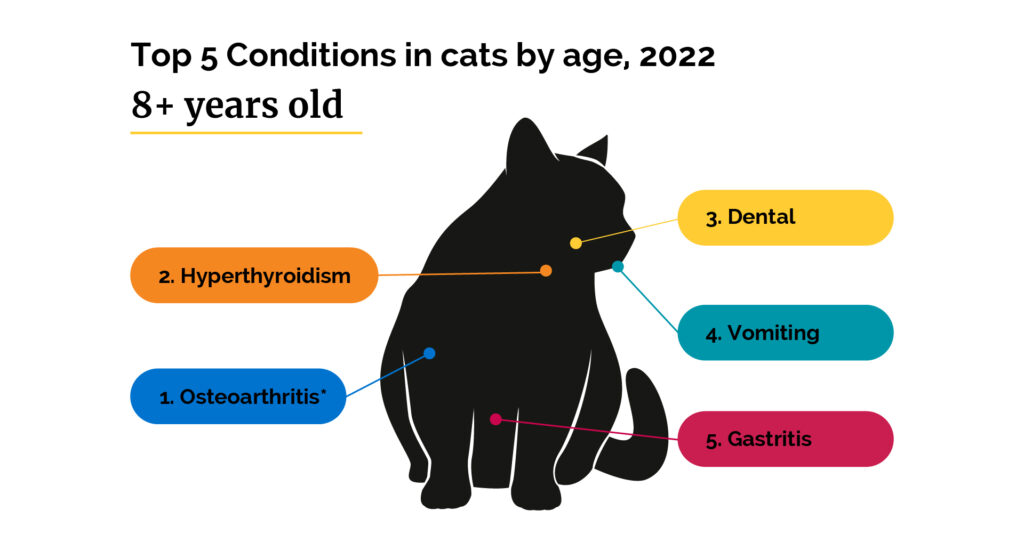
Top 5 Conditions 8 + years old
- 1. Osteoarthritis
- 2. Hyperthyroidism
- 3. Dental Disease
- 4. Vomiting
- 5. Gastritis
Osteoarthritis
Degenerative joint disease, often known as osteoarthritis, or simply arthritis affects cats particularly as they get older. Arthritis is a notoriously painful condition, as the cartilage padding that protects the joints wears away and the bones begin to rub on one another. It can be difficult to tell if your cat is suffering from arthritis. Signs can range from weight loss, lack of grooming, going to the toilet in unusual locations, mood changes as well as changes in mobility or willingness to jump or climb. These all may be signs that your cat is in pain.
Arthritis typically worsens with time, but there are ways to help slow its progress as well as manage the symptoms.
- Making litter trays more accessible by buying trays with lower sides
- Lots of soft and cosy bedding
- Weight loss in cats carrying extra weight can help reduce the load on the joints
- Increased exercise helps to build muscle strength which helps protect the joints
- Elevating food and water bowls for ease of access
- Non-steroidal anti-inflammatory medications as recommended by the vet
- Steps to help cats easily access higher furniture
- Mats on slippery flooring to help prevent exacerbating arthritis
- Keeping older cats safely indoors
- Nutraceuticals and nutritional supplements
- Alternative therapies which may include acupuncture, physical rehabilitation or medical massage
Hyperthyroidism
The thyroid is a gland found in the neck of mammals. The hormones it produces play a vital role in many body processes including metabolism, heart, digestion, and muscle functions. In hyperthyroidism, changes to the thyroid mean that it produces more hormones than the body needs. Because the thyroid affects so many body processes, the symptoms of hyperthyroidism can vary between individuals and affect different body systems. Some signs of hyperthyroidism in cats include an increase in thirst and appetite, usually with concurrent weight loss, changes in behaviour, more vocal and restless, and some may be more aggressive.
Hyperthyroid cats may also have an unkempt appearance to the coat, vomiting and diarrhea and may even be weak or lethargic. While there isn’t much you can do to prevent hyperthyroidism, early diagnosis and treatment means a much better chance of reducing complications due to hyperthyroidism and improved quality of life and longevity.
Pet insurance can help by covering a portion of the eligible vet bill if the unexpected happens. Because it is difficult to predict the costs of veterinary care, it can help to have measures in place to help prepare for the unexpected. Check out our partner network and explore our policy tools to find a pet insurance policy.
Not all conditions or items are covered by Pet Insurance. Refer to the applicable Product Disclosure Statement for information about coverage and exclusions.



 Fact checked
Fact checked
